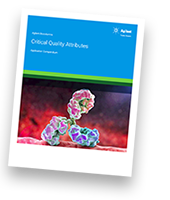Involved in CQA monitoring? Looking for reliable HPLC methods suitable for the various aspects of this work? If so, the 'Critical Quality Attributes: Applications Compendium' is what you're looking for.
 Biotherapeutic proteins are highly complex molecules, which are typically produced by fermentation using recombinant methodologies. This production process however, results in the generation of many different variants of these proteins. Ensuring the quality of such materials is paramount. This means confirming the product is correctly manufactured, any impurities are identified and quantified, and the potency of the protein is determined.
Biotherapeutic proteins are highly complex molecules, which are typically produced by fermentation using recombinant methodologies. This production process however, results in the generation of many different variants of these proteins. Ensuring the quality of such materials is paramount. This means confirming the product is correctly manufactured, any impurities are identified and quantified, and the potency of the protein is determined.
As a result, it is necessary to perform tests on the intact, nondenatured molecule. Something as large as a monoclonal antibody may contain more than 1,300 individual amino acids and have a mass of more than 145,000 daltons. However, identifying a single minor impurity such as deamidation of asparagine resulting in a mass difference of just one dalton, which may occur at any of perhaps twenty or more different asparagine positions throughout the molecule, is challenging. Only by breaking down the molecule into fragments (such as light and heavy chains) and then into smaller polypeptide chains through enzymatic treatment is it possible to begin to pinpoint some of these subtle differences.
Many different types of variant can be created and these are often referred to as posttranslational modifications, or PTMs. They arise after the protein has been expressed, and can be a consequence of the manufacturing conditions, or exposure to conditions that cause changes to occur. Fluctuations in temperature, pH, concentration, or exposure to enzymes can all lead to variants developing. Glycosylation in particular is highly variable but is of major importance to the efficacy of many proteins. Understanding the different types of impurity and the risks each pose forms the basis of Critical Quality Attribute (CQA) monitoring.
The purpose of this document is to highlight some of the HPLC applications suitable for the different aspects of CQA monitoring. As well as providing guidance for the appropriate liquid chromatography column for the different types of detection that may be required, and to provide a valuable reference for future consideration.
Visit the 'Advances in Biomolecule Analysis' learning hub to download your copy...




